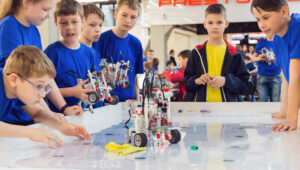Using Lego to learn the building blocks of programming

Anthony Moran, head of computer science and STEAM at The English College, Dubai, explores the role of LEGO in enhancing computing education and programming skills in young learners.
Computing, especially programming, is constantly evolving, which poses challenges when it comes to introducing students to these ideas. The concept of programming as a cryptic, foreign language and the stereotype of programmers as socially isolated ‘geeks’ can deter many students from engaging with this multifaceted subject. The fear of failure is another reason that often stops children from progressing to moments of true discovery, as they might abandon their efforts at the first sign of difficulty, not realising that significant learning often comes from overcoming these challenges.
The role of Lego
This is where LEGO comes in, bridging the gap between learning traditionally challenging concepts and having fun. LEGO is a tool long celebrated for fostering imagination in kids, allowing them to construct their own interpretations of scenarios and articulate their thought processes. By progressing from simple, familiar constructions to more sophisticated robotics kits such as LEGO ‘Spike Prime’, students are presented with more advanced concepts in an easy-to-digest manner that feels exciting and encouraging. These kits are aimed at showing students the fundamentals of robotics, engineering and coding, and are great for increasing students’ enthusiasm not only for building, but also for programming their creations to interact with the world.
Advanced skills
The engaging nature of robotics and LEGO kits introduces students to complex programming and engineering principles in an accessible way. Encouraging students to persist through failures, thereby developing resilience and interdisciplinary skills in areas like maths and physics, is crucial in preparing them for future challenges. Collaborative work on LEGO robotics projects also mirrors industry practices, promoting an iterative process of brainstorming, designing, building, coding and testing, with a constant aim for improvement.
This approach demystifies computing for students, making even sophisticated robotics seem approachable and relevant across different age groups. By interacting with LEGO robotics, students practise programming constructs like sequence, selection and iteration, gaining skills applicable to advanced academic levels – often without even realising it.
Looking to the future
The adaptability of the programming tools, ranging from icon and word blocks, to Python, allows students to gradually build confidence and proficiency, smoothly and subtly preparing them for formal assessments down the line.
The future of LEGO robotics in computing education is promising, offering new ways to engage with technology while grounding students in essential concepts that extend beyond traditional classroom settings. By keeping pace with emerging technologies, LEGO can continue to be an indispensable asset in preparing students for a rapidly evolving technological landscape.
Combining LEGO with computing education creates an ideal setting for nurturing future innovators. Through every challenging project and each line of code that doesn’t work as expected, students learn about robotics and, more importantly, the critical lesson that true learning involves a cycle of trials, failures and triumphs. As a learning tool, LEGO is a wonderful and universally loved way to merge play and progress, pushing students to develop their understanding of STEM concepts while having lots of fun!
Image Credit: Shutterstock











Comments